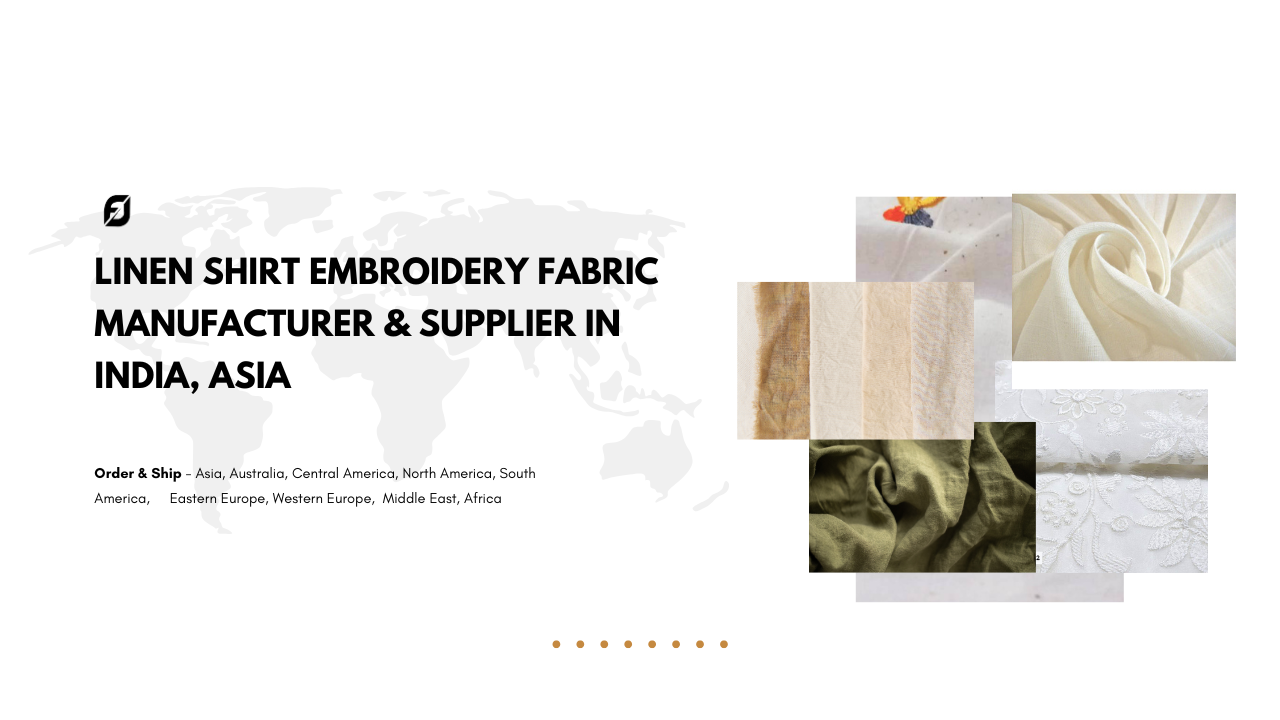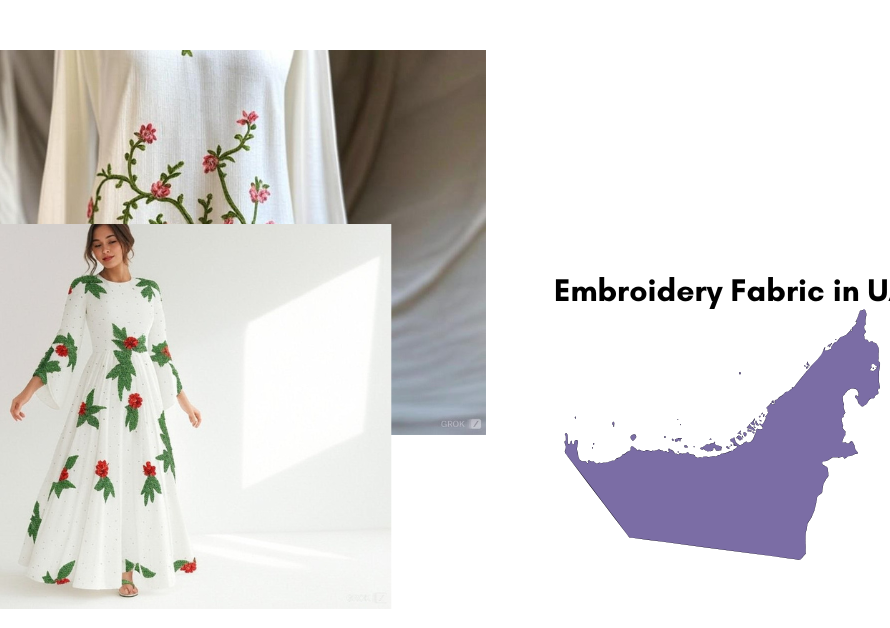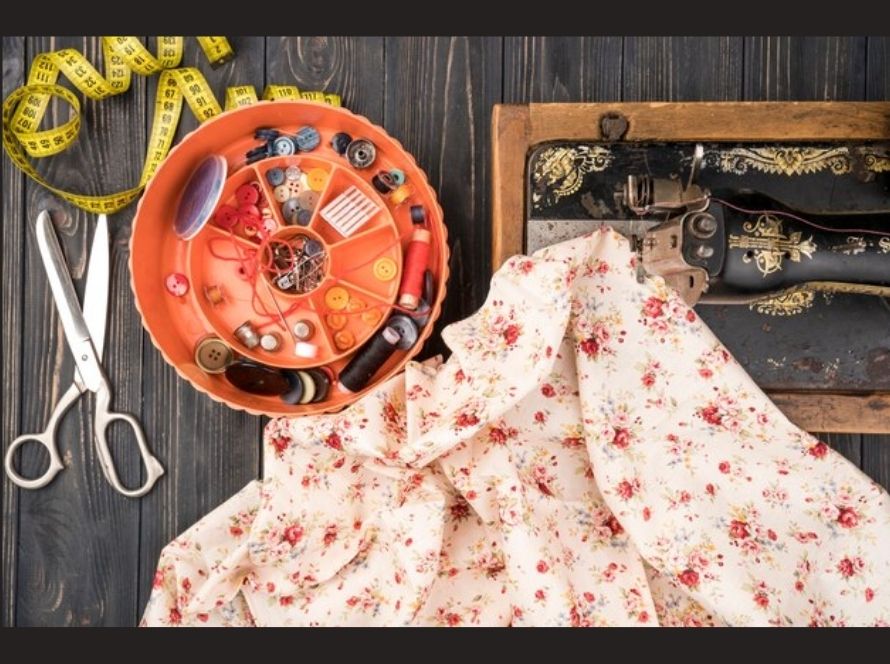Muslin fabric is one of the most versatile and widely used textiles in the world, known for its softness, breathability, and lightweight texture.
Originating from ancient India, this fabric has been a staple for centuries and continues to evolve in modern fashion. Muslin is made from fine cotton yarn, making it ideal for a variety of garments.
Muslin Embroidery Fabric: A Global Trend with Madhav Fashion Leading the Way
From muslin cotton, which is popular in summer clothing, to the heavier viscose muslin, this fabric is highly adaptable to different styles and climates.
What is Muslin Fabric?
Muslin fabric is a plain weave cotton fabric that is light, breathable, and easy to work with. The fine quality of this fabric makes it popular for summer dresses, baby clothing, curtains, and even in crafting. Muslin is also known for its ability to absorb dyes easily, which makes it a popular choice for dyeable fabrics.
Popular Garments Made from Muslin
Muslin fabric is widely used in making:
- Summer dresses and kurtis
- Light sarees and dupattas
- Casual wear like shirts and blouses
- Baby wraps and bedding
- Craft and household items
Can Embroidery Be Done on Muslin Fabric?
Yes, embroidery on muslin fabric is not only possible but highly popular. The smooth texture of muslin allows for intricate embroidery designs, which elevate the fabric from simple to stunning. Muslin embroidery fabric is used in everything from ethnic wear like kurtis, sarees, and lehengas to Western wear like dresses, skirts, and blouses. With its breathable quality, embroidered muslin garments are comfortable to wear, especially in warmer climates.
Types of Muslin Fabric
Muslin fabric comes in several varieties:
- Cotton Muslin: Soft and lightweight, ideal for summer clothing.
- Viscose Muslin: Heavier than cotton muslin, used for more structured garments.
- Printed Muslin: Muslin can be printed in various designs, making it perfect for casual wear.
- Dyeable Muslin: This form allows for customization, as the fabric can be dyed in any color.
- Embroidery Muslin: Specially designed for intricate embroidery work, enhancing the beauty of the fabric.
Differences Between Dyeable, Print, Color, and Embroidery Muslin
- Dyeable Muslin: Allows customization of colors according to fashion trends.
- Printed Muslin: Comes with pre-applied designs, perfect for casual and everyday wear.
- Colored Muslin: Available in a wide range of solid colors.
- Embroidery Muslin: Features intricate embroidered patterns, adding elegance to the fabric.
Madhav Fashion: Creating the Best Muslin Embroidery Fabric
Madhav Fashion is a leading manufacturer specializing in muslin embroidery fabric. Their fabrics are renowned for their high quality, durability, and exquisite designs. Madhav Fashion focuses on creating unique patterns using advanced techniques, ensuring that their muslin embroidery fabrics are not only stylish but also highly durable. Whether it’s white muslin, muslin cotton, or viscose muslin, their embroidery work adds a touch of sophistication, making their fabrics highly sought-after across the globe.
The rise in demand for muslin embroidery fabric can be attributed to its increasing use in luxury and fashion markets. With Madhav Fashion leading the way, their muslin fabrics have become a global trend, meeting the needs of fashion designers and garment manufacturers worldwide.
Muslin fabric, with its versatility and lightness, is a timeless material that is increasingly popular in fashion. Whether you’re looking for muslin near me for everyday wear or for crafting, or you’re a designer in search of the finest muslin embroidery fabric, Madhav Fashion offers the highest quality and variety. From dyeable to embroidered muslin, Madhav Fashion is setting trends with their innovative designs and global appeal.
______________________________________________________
What is Muslin Fabric, and Why is it Popular?
Muslin fabric is a plain weave cotton textile that originated in ancient India and is widely known for its lightweight and breathable qualities. Its popularity stems from its soft texture and versatility, making it suitable for a variety of garments and uses. The fabric is made from fine cotton yarns, giving it a smooth and airy feel. It is particularly popular in tropical climates because it allows air circulation and helps the wearer stay cool.
In modern times, muslin is commonly used in summer dresses, baby clothing, and even in the household as curtains and bed linens. It is also widely used in crafting and design because of its ability to be easily dyed and manipulated. Additionally, muslin is inexpensive, which makes it an accessible option for designers and consumers alike. Its adaptability and the growing trend toward eco-friendly fabrics have further increased its demand globally. Muslin can be found in different weights, making it suitable for various purposes, from light clothing to heavier fabrics like viscose muslin for more structured garments.
Can Embroidery Be Done on Muslin Fabric?
Yes, embroidery can be done on muslin fabric, and it’s a popular choice for creating elegant, lightweight garments with intricate designs. The smooth, tightly woven texture of muslin allows for easy needlework, making it ideal for both machine and hand embroidery. Whether it’s traditional embroidery like satin stitch or more complex patterns like beading or sequins, muslin’s fine surface accommodates a wide range of embroidery techniques.
Muslin embroidery fabric is frequently used in making ethnic and formal attire, such as kurtis, sarees, and lehengas, but it’s also common in Western fashion for creating embellished dresses, blouses, and skirts. One of the major advantages of embroidering on muslin is that the fabric’s lightness ensures that even intricate designs don’t make the garment too heavy, maintaining comfort for the wearer.
Muslin embroidery also takes well to dyeing and customization, so the color and design possibilities are nearly endless. Designers around the world favor muslin for creating embroidery-heavy garments because it strikes the perfect balance between durability and delicacy.
What Are the Types of Muslin Fabric Available?
Muslin fabric comes in several varieties, each suited to different uses and preferences. Here are the main types of muslin fabric:
- Cotton Muslin: This is the most common type of muslin, made from 100% cotton. It is lightweight and breathable, making it ideal for casual clothing, baby wear, and home textiles like curtains and bed sheets.
- Viscose Muslin: A heavier form of muslin that offers more structure than cotton muslin. Viscose muslin is often used for more formal garments, such as blouses, dresses, and kurtis that require a bit more weight.
- Printed Muslin: Muslin that comes with pre-applied prints in a variety of designs. Printed muslin is popular for casual wear and everyday garments as it adds a decorative touch without the need for additional embellishments.
- Dyeable Muslin: This type is perfect for designers and consumers who want to customize their fabrics. Dyeable muslin allows for easy color application to create unique hues for specific projects.
- Embroidery Muslin: Specially designed to accommodate intricate needlework, embroidery muslin is smoother and more durable than standard muslin, making it ideal for embellished garments.
How Does Madhav Fashion Create the Best Muslin Embroidery Fabric?
Madhav Fashion stands out as a leader in muslin embroidery fabric production due to its dedication to quality, innovation, and craftsmanship. The company employs state-of-the-art technology and traditional handwork techniques to produce muslin fabrics that are both stylish and durable. Each piece of muslin embroidery fabric from Madhav Fashion undergoes rigorous quality control to ensure that it meets global standards for both aesthetics and functionality.
One of the key strengths of Madhav Fashion is its ability to create intricate designs on muslin while maintaining the fabric’s natural lightness. Their collection includes a variety of embroidered muslin, ranging from traditional ethnic patterns to modern, trend-driven designs. The versatility of their muslin embroidery fabrics makes them popular worldwide for making everything from lehengas and sarees to dresses, blouses, and even baby wear. Madhav Fashion’s commitment to sustainable practices also means that their fabrics are eco-friendly, adding to their appeal in international markets.
What Are the Main Uses of Muslin Fabric in Fashion?
Muslin fabric is widely used in fashion due to its versatility, lightweight texture, and breathability. Some of the main uses include:
- Summer Clothing: Muslin is perfect for making summer dresses, kurtis, and blouses because of its breathable nature. The fabric helps keep the body cool in warm climates.
- Ethnic Wear: Muslin is popular in India and other regions for creating traditional garments like sarees, dupattas, and lehengas. The fabric’s smooth texture and ability to take on intricate embroidery make it a favorite for ethnic wear.
- Baby Clothes: Muslin’s softness and breathability make it ideal for baby wraps, swaddles, and clothing. Its hypoallergenic properties also make it safe for sensitive skin.
- Casual Wear: Muslin shirts, tunics, and skirts are commonly worn for casual, everyday outfits due to their comfort and style.
- Household Textiles: Muslin is used for items like curtains, tablecloths, and bed linens because of its lightness and ability to filter natural light while maintaining privacy.
Muslin’s adaptability across different garment types makes it one of the most popular fabrics in the global fashion industry.
What Are the Differences Between Dyeable, Print, Color, and Embroidery Muslin?
Muslin fabric comes in various forms, each offering unique advantages based on the desired use:
- Dyeable Muslin: This is plain muslin fabric that hasn’t been dyed, allowing designers or manufacturers to customize its color. It’s a popular choice for those looking to match specific color schemes or fashion trends.
- Printed Muslin: This fabric comes with pre-applied patterns and designs, eliminating the need for further embellishment. Printed muslin is typically used for casual garments and home textiles.
- Colored Muslin: Unlike dyeable muslin, colored muslin is pre-dyed and ready to use. It’s available in a wide range of colors, catering to different fashion needs.
- Embroidery Muslin: Designed specifically for intricate needlework, embroidery muslin features beautiful, handcrafted or machine-stitched designs. It’s used in both ethnic and modern garments to add a touch of elegance and luxury.
The main difference lies in how each form can be used—whether for customization, patterning, or embellishment. Each type of muslin offers a unique way to enhance the fabric for various fashion needs.
What Are the Environmental Benefits of Muslin Fabric?
Muslin fabric is environmentally friendly due to its natural cotton origins and sustainable production methods. As a biodegradable fabric, muslin does not contribute to the long-lasting waste associated with synthetic materials like polyester. Additionally, many muslin manufacturers, including Madhav Fashion, are committed to eco-friendly practices, such as using natural dyes and minimizing water waste in production.
Muslin’s lightweight texture also requires less energy to produce, making it a more sustainable option compared to heavier fabrics. The fabric’s durability means it can be reused and recycled, reducing the need for constant replacements. Furthermore, muslin is hypoallergenic and does not require harmful chemicals for its production, which is beneficial both for the environment and for those with sensitive skin. Choosing muslin over synthetic fabrics can significantly reduce your carbon footprint, making it a responsible choice for eco-conscious consumers.
Why Is Muslin Fabric So Comfortable for Summer Wear?
Muslin fabric is renowned for its comfort in warm weather because of its lightweight and breathable texture. The fabric is made from fine cotton fibers woven in a way that allows for excellent airflow, making it ideal for summer garments like dresses, kurtis, and blouses. Unlike synthetic fabrics, which can trap heat and moisture, muslin absorbs sweat and promotes ventilation, helping to keep the wearer cool.
Its softness adds to the comfort, ensuring that the fabric doesn’t irritate the skin, even when worn for extended periods. Additionally, muslin can be easily dyed in light colors, which reflect sunlight and further enhance the fabric’s cooling effect. Because of its ability to stay cool and dry, muslin is a go-to fabric for summer wardrobes worldwide, from casual wear to more formal garments like sarees and kurtis.
How Has Muslin Embroidery Fabric Become Popular Worldwide?
Muslin embroidery fabric has gained immense popularity worldwide due to its unique combination of comfort, style, and versatility. Embroidery adds a decorative element to muslin’s natural lightness, making it a fashionable choice for both ethnic and Western garments. As global fashion trends shift toward sustainable and eco-friendly textiles, muslin’s natural cotton composition and ability to support intricate designs make it highly desirable.
Designers around the world have embraced muslin embroidery fabric for creating elegant, breathable clothing that stands out with its detailed embroidery. Madhav Fashion, in particular, has helped propel muslin embroidery fabric to the global stage by producing high-quality, exquisitely designed fabrics that cater to diverse markets. From luxury bridal gowns to everyday casual wear, muslin embroidery fabric’s versatility has made it a staple in the global fashion industry.






